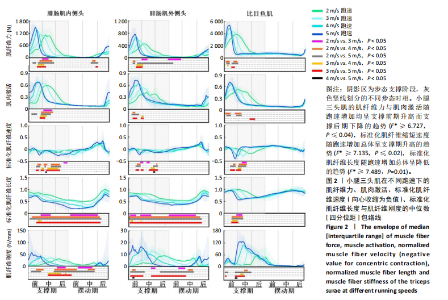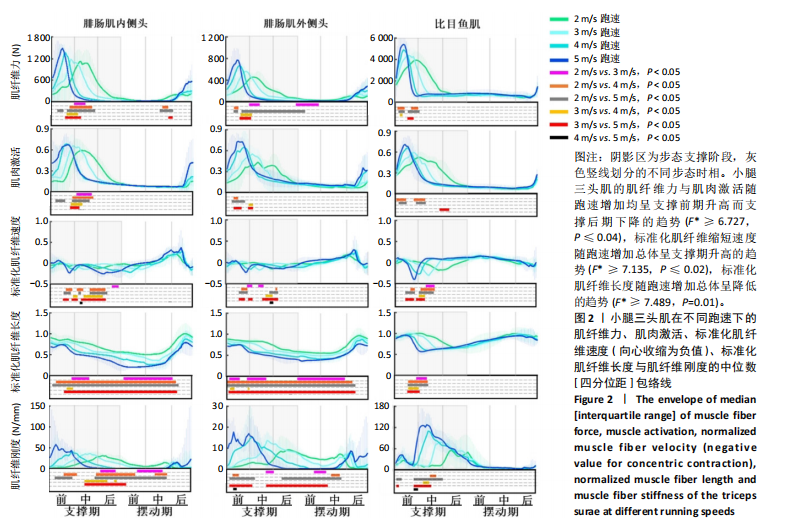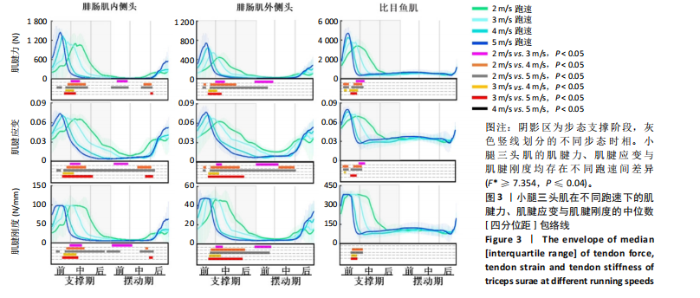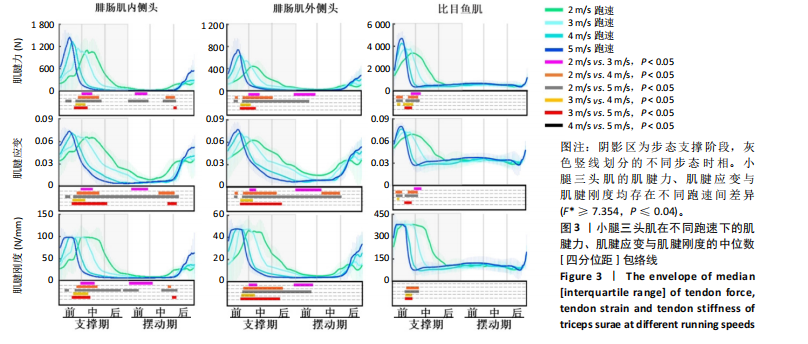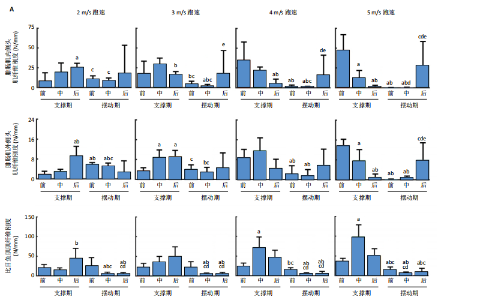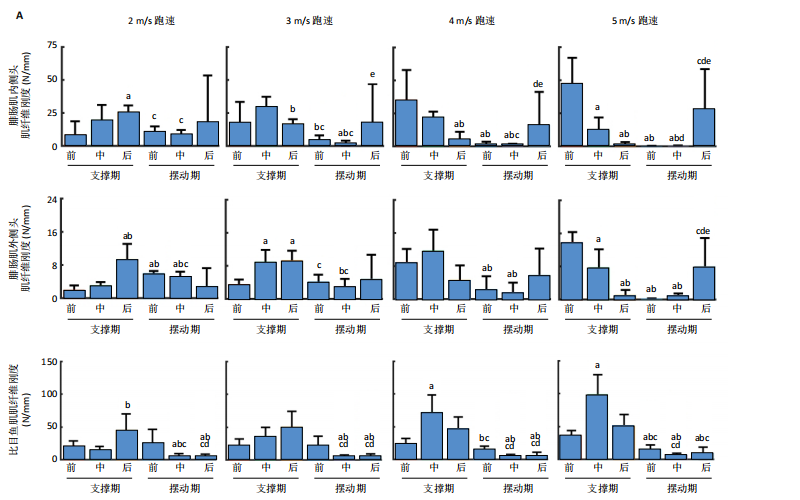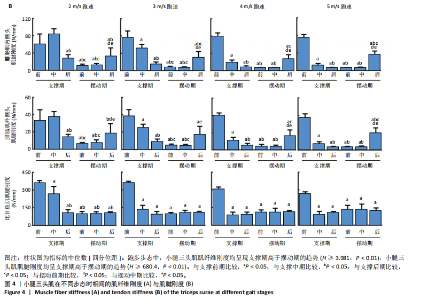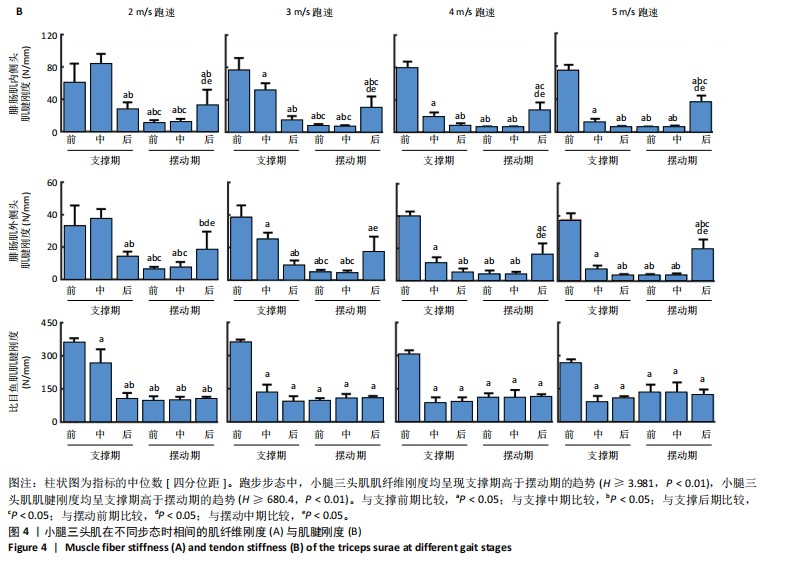Chinese Journal of Tissue Engineering Research ›› 2025, Vol. 29 ›› Issue (35): 7529-7536.doi: 10.12307/2025.956
Previous Articles Next Articles
Simulation analysis of real-time continuous stiffness in muscle fibers and tendons of the triceps surae during multi-joint movement
Li Chen, Liu Ye, Ni Xindi, Zhang Yuang
- School of Sport Science, Beijing Sport University, Beijing 100084, China
-
Received:2024-10-14Accepted:2024-12-03Online:2025-12-18Published:2025-04-30 -
Contact:Liu Ye, PhD, Professor, School of Sport Science, Beijing Sport University, Beijing 100084, China -
About author:Li Chen, Master, School of Sport Science, Beijing Sport University, Beijing 100084, China -
Supported by:the Fundamental Research Funds for the Central Universities, No. 2018PT004 (to LY)
CLC Number:
Cite this article
Li Chen, Liu Ye, Ni Xindi, Zhang Yuang. Simulation analysis of real-time continuous stiffness in muscle fibers and tendons of the triceps surae during multi-joint movement[J]. Chinese Journal of Tissue Engineering Research, 2025, 29(35): 7529-7536.
share this article
Add to citation manager EndNote|Reference Manager|ProCite|BibTeX|RefWorks
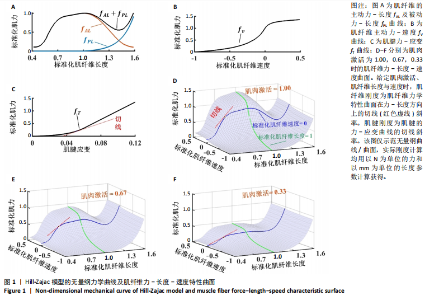
2.1 不同跑速下肌纤维收缩行为及实时刚度差异 小腿三头肌的肌纤维力与肌肉激活随跑速增加均呈支撑前期升高而支撑后期下降的趋势(F*≥6.727,P≤0.04),标准化肌纤维缩短速度随跑速增加总体呈支撑期升高的趋势(F*≥7.135,P≤0.02),标准化肌纤维长度随跑速增加总体呈降低的趋势(F*≥7.489, P=0.01),见图2。在2 m/s vs. 3 m/s、2 m/s vs. 4 m/s、2 m/s vs. 5 m/s、3 m/s vs. 4 m/s、3 m/s vs. 5 m/s、4 m/s vs. 5 m/s的相互比较中,得到以下结果:①相比较低跑速(2,3,4 m/s),对应较高跑速(3,4,5 m/s)下:小腿三头肌肌纤维力与肌肉激活在支撑前期更高(P≤0.02),而在支撑中后期更低(P≤0.03);腓肠肌标准化肌纤维速度(绝对值)在支撑期内更高(P≤0.02),比目鱼肌标准化肌纤维速度(绝对值)在支撑前期更高(P≤0.01),比目鱼肌标准化肌纤维速度(绝对值)在支撑中期更低(P≤0.01)。②相比较低跑速(2,3 m/s),对应较高跑速(3,4,5 m/s)下的腓肠肌标准化肌纤维长度在几乎整个支撑期及摆动前中期时更低(P≤0.02),而比目鱼肌标准化肌纤维长度仅在支撑中期更低(P≤0.02)。 跑速变化时,小腿三头肌肌纤维激活-长度-速度瞬时状态即时调节,使肌纤维刚度随跑速增加总体呈支撑期升高而摆动期降低的趋势(F*≥8.948,P≤0.05)(图2),并且在腓肠肌和比目鱼肌中的表现不同。相比较低跑速(2,3,4 m/s),对应较高跑速(3,4,5 m/s)下的腓肠肌肌纤维刚度在支撑前期更高(P≤0.03),而在支撑中后期与摆动前中期更低(P≤0.03),比目鱼肌的肌纤维刚度在支撑前期及中期更高(P≤0.02)。 2.2 不同跑速下肌腱行为及实时刚度差异 小腿三头肌的肌腱力、肌腱应变与肌腱刚度均存在不同跑速间差异(F* ≥7.354,P≤0.04),见图3。在2 m/s vs. 3 m/s、2 m/s vs. 4 m/s、2 m/s vs. 5 m/s、3 m/s vs. 4 m/s、3 m/s vs. 5 m/s、4 m/s vs. 5 m/s的相互比较中,得到以下结果:①在支撑前期,小腿三头肌在较高跑速(3,4,5 m/s)下的肌腱力及肌腱应变高于对应较低跑速(2,3 m/s)(P≤0.02),腓肠肌内侧头肌腱刚度在5 m/s跑速高于2 m/s跑速(P≤0.02)。②在支撑中后期,比目鱼肌在较高跑速(4,5 m/s)下的肌腱力、肌腱应变与肌腱刚度低于较低跑速时(2,3 m/s)(P≤0.03)。在支撑中后期及摆动前中期,腓肠肌在较高跑速(4,5 m/s)下的肌腱力、肌腱应变与肌腱刚度低于较低跑速(2,3 m/s)(P≤0.03),腓肠肌在3 m/s跑速下的肌腱力、肌腱应变与肌腱刚度低于2 m/s跑速(P≤0.03)。 2.3 不同时相间的肌纤维刚度与肌腱刚度差异 跑步步态中,小腿三头肌肌纤维刚度均呈现支撑期高于摆动期的趋势(H≥3.981,P < 0.01),见图4A。在3,4,5 m/s跑速下,腓肠肌内侧头肌纤维刚度在摆动后期高于摆动前中期(P≤0.03)。在5 m/s跑速下,腓肠肌外侧头肌纤维刚度在摆动后期高于摆动前中期(P < 0.01),比目鱼肌肌纤维刚度在支撑期高于摆动期(P < 0.01)。在较低跑速(2 m/s和3 m/s)下,腓肠肌肌纤维刚度在支撑期高于摆动前中期(P≤0.03),比目鱼肌肌纤维刚度在支撑期高于摆动中后期(P≤0.01)。 跑步步态中,小腿三头肌肌腱刚度均呈支撑期高于摆动期的趋势(H ≥680.4,P < 0.01),见图4B。在较高跑速(4 m/s和5 m/s)下,腓肠肌肌腱刚度在支撑前中期及摆动后期均高于支撑后期至摆动中期(P < 0.02)。在3,4,5 m/s跑速下,比目鱼肌肌腱刚度在支撑前期高于支撑中期至摆动后期(P < 0.02)。在较低跑速(2 m/s和3 m/s)下,腓肠肌肌腱刚度在支撑期及摆动后期均高于摆动前中期(P≤0.03)。在2 m/s跑速下,比目鱼肌肌腱刚度在支撑前中期高于支撑后期至摆动后期(P < 0.01)。"
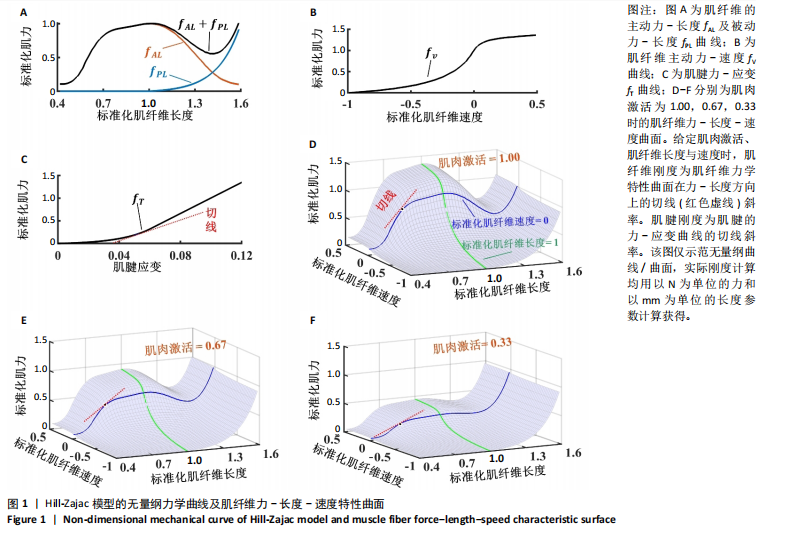
| [1] 赵虎,霍洪峰.跑步运动中下肢刚度的应用与研究进展[J].中国体育科技,2022,58(10):63-71. [2] BAYRAK E, YILGOR HURI P. Engineering musculoskeletal tissue interfaces. Front Mater. 2018;5:24. [3] KIM WJ, KIM GH. A bioprinted complex tissue model for myotendinous junction with biochemical and biophysical cues. Bioeng Transl Med. 2022;7:e10321. [4] KUBO K. Active muscle stiffness in the human medial gastrocnemius muscle in vivo. J Appl Physiol (1985). 2014;117(9):1020-1026. [5] KUBO K, MIYAZAKI D, YATA H, et al. Mechanical properties of muscle and tendon at high strain rate in sprinters. Physiol Rep. 2020;8:e14583. [6] UCHIDA TK. Biomechanics of movement : The science of sports, robotics, and rehabilitation. MIT Press, 2021. [7] CAPURRO M, BARBERIS F. 9-evaluating the mechanical properties of biomaterials//DUBRUEL P, VLIERBERGHE S. Biomaterials for bone regeneration. Woodhead Publishing, 2014:270-323. [8] MIHAI LA, GORIELY A. How to characterize a nonlinear elastic material? A review on nonlinear constitutive parameters in isotropic finite elasticity. Proc Math Phys Eng Sci. 2017;473:20170607. [9] JAKUBOWSKI KL, LUDVIG D, PERREAULT EJ, et al. Non-linear properties of the achilles tendon determine ankle impedance over a broad range of activations in humans. J Exp Biol. 2023;226(14):jeb244863. [10] ZATSIORSKY V. Biomechanics in sport: Performance enhancement and injury prevention. John Wiley & Sons, 2008. [11] NISHIKAWA K. Eccentric contraction: Unraveling mechanisms of force enhancement and energy conservation. J Exp Biol. 2016;219:189-196. [12] RAITERI BJ, CRESSWELL AG, LICHTWARK GA. Muscle-tendon length and force affect human tibialis anterior central aponeurosis stiffness in vivo. Proc Natl Acad Sci U S A. 2018;115:E3097-e3105. [13] ZAJAC FE. Muscle and tendon: Properties, models, scaling, and application to biomechanics and motor control. Crit Rev Biomed Eng. 1989;17(4):359-411. [14] 赵虎,霍洪峰,马晓子.Opensim环境下扁平足步态支撑期踝周肌群肌力分析[J].中国运动医学杂志,2023,42(2):93-101. [15] AMBRÓSIO JAC, KECSKEMÉTHY A. Multibody dynamics of biomechanical models for human motion via optimization. Dordrecht: Springer Netherlands, 2007:245-272. [16] MONTE A, BALTZOPOULOS V, MAGANARIS CN, et al. Gastrocnemius medialis and vastus lateralis in vivo muscle-tendon behavior during running at increasing speeds. Scand J Med Sci Sports 2020;30(7):1163-1176. [17] GALLO RA, PLAKKE M, SILVIS ML. Common leg injuries of long-distance runners: Anatomical and biomechanical approach. Sports Health. 2012;4:485-495. [18] ARNOLD EM, HAMNER SR, SETH A, et al. How muscle fiber lengths and velocities affect muscle force generation as humans walk and run at different speeds[J]. J Exp Biol. 2013;216(Pt 11):2150-2160. [19] 梅齐昌,相亮亮,李建设,等.基于一维统计参数映射分析跑者跑步地面反作用力差异[J].医用生物力学,2021,36(5):684-691. [20] SAWACHA Z, SPOLAOR F, PIĄTKOWSKA WJ, et al. Feasibility and reliability assessment of video-based motion analysis and surface electromyography in children with fragile x during gait. Sensors (Basel). 2021;21(14):4746. [21] LI C, LIU Y. Regional differences in behaviors of fascicle and tendinous tissue of the biceps femoris long head during hamstring exercises. J Electromyogr Kinesiol. 2023;72:102812. [22] BAŃKOSZ Z, WINIARSKI S. Statistical parametric mapping reveals subtle gender differences in angular movements in table tennis topspin backhand. Int J Environ Res Public Health. 2020;17(19):6996. [23] LIEBER RL, FRIDÉN J. Mechanisms of muscle injury gleaned from animal models. Am J Phys Med Rehabil. 2002;81(11 Suppl):S70-79. [24] MACIEJEWSKA-SKRENDO A, LEŹNICKA K, LEOŃSKA-DUNIEC A, et al. Genetics of muscle stiffness, muscle elasticity and explosive strength. J Hum Kinet. 2020;74:143-159. [25] CLARK WH, FRANZ JR. Age-related changes to triceps surae muscle-subtendon interaction dynamics during walking. Sci Rep. 2021;11(1): 21264. [26] YONG JR, DEMBIA CL, SILDER A, et al. Foot strike pattern during running alters muscle-tendon dynamics of the gastrocnemius and the soleus. Sci Rep. 2020;10(1):5872. [27] FARRAG A, ALMUSALLAM M, ALMULHIM N, et al. The effect of knee angle and subject position on plantar flexors isokinetic performance and muscular activity. Isokinet Exerc Sci. 2022;30:193-201. [28] QUINLAN JI, FRANCHI MV, GHARAHDAGHI N, et al. Muscle and tendon adaptations to moderate load eccentric vs. Concentric resistance exercise in young and older males. Geroscience. 2021;43(4):1567-1584. [29] LEGERLOTZ K, RILEY GP, SCREEN HR. Specimen dimensions influence the measurement of material properties in tendon fascicles. J Biomech. 2010;43(12):2274-2280. [30] BAI D, OKADA Y, FUKUMOTO T, et al. The muscle pre-activity timing of the hamstrings and quadriceps during 180° and 360° rotational jump landings in healthy female subjects. Asia Pac J Sports Med Arthrosc Rehabil Technol. 2019;17:16-20. [31] MOORE IS. Is there an economical running technique? A review of modifiable biomechanical factors affecting running economy. Sports Med. 2016;46(6):793-807. |
| [1] | Chen Xi, Tang Tao, Chen Tongbing, Li Qing, Zhang Wen. Mechanical stability of intertrochanteric fracture of femur with different internal fixation systems [J]. Chinese Journal of Tissue Engineering Research, 2025, 29(9): 1783-1788. |
| [2] | Ao Xiaojing, Li Kun, Liu Yuhang, Yang Xiaoxuan, Wang Xing, Li Zhijun, Ren Xiaoyan, Zhang Shaojie. Development and application of a three-dimensional digital visualization system for children’s neck acupoints [J]. Chinese Journal of Tissue Engineering Research, 2025, 29(9): 1834-1840. |
| [3] | Li Kaiying, Wei Xiaoge, Song Fei, Yang Nan, Zhao Zhenning, Wang Yan, Mu Jing, Ma Huisheng. Mechanism of Lijin manipulation regulating scar formation in skeletal muscle injury repair in rabbits [J]. Chinese Journal of Tissue Engineering Research, 2025, 29(8): 1600-1608. |
| [4] | Chen Yueping, Chen Feng, Peng Qinglin, Chen Huiyi, Dong Panfeng . Based on UHPLC-QE-MS, network pharmacology, and molecular dynamics simulation to explore the mechanism of Panax notoginseng in treating osteoarthritis [J]. Chinese Journal of Tissue Engineering Research, 2025, 29(8): 1751-1760. |
| [5] | Li Dijun, Jiu Jingwei, Liu Haifeng, Yan Lei, Li Songyan, Wang Bin. Three-dimensional gelatin microspheres loaded human umbilical cord mesenchymal stem cells for chronic tendinopathy repair [J]. Chinese Journal of Tissue Engineering Research, 2025, 29(7): 1356-1362. |
| [6] |
Zhang Bo, Zhang Zhen, Jiang Dong.
Tannic acid modified interpenetrating network hydrogel promotes tissue remodeling of ruptured Achilles tendon after surgery#br#
#br#
[J]. Chinese Journal of Tissue Engineering Research, 2025, 29(4): 721-729.
|
| [7] | Fang Yuan, Qian Zhiyong, He Yuanhada, Wang Haiyan, Sha Lirong, Li Xiaohe, Liu Jing, He Yachao, Zhang Kai, Temribagen. Mechanism of Mongolian medicine Echinops sphaerocephalus L. in proliferation and angiogenesis of vascular endothelial cells [J]. Chinese Journal of Tissue Engineering Research, 2025, 29(35): 7519-7528. |
| [8] | Yang Bo, Pan Xinfang, Chang Liuhui, Ni Yong. Correlation of echocardiographic parameters with disability at 3 months after acute ischemic stroke [J]. Chinese Journal of Tissue Engineering Research, 2025, 29(35): 7544-7551. |
| [9] | Liu Xuan, Ding Yuqing, Xia Ruohan, Wang Xianwang, Hu Shujuan. Exercise prevention and treatment of insulin resistance: role and molecular mechanism of Keap1/nuclear factor erythroid2-related factor 2 signaling pathway [J]. Chinese Journal of Tissue Engineering Research, 2025, 29(35): 7578-7588. |
| [10] | Gong Yuehong, Wang Mengjun, Ren Hang, Zheng Hui, Sun Jiajia, Liu Junpeng, Zhang Fei, Yang Jianhua, Hu Junping. Machine learning combined with bioinformatics screening of key genes for pulmonary fibrosis associated with cellular autophagy and experimental validation [J]. Chinese Journal of Tissue Engineering Research, 2025, 29(35): 7679-7689. |
| [11] | Han Jie, Pan Chengzhen, Shang Yuzhi, Zhang Chi. Identification of immunodiagnostic biomarkers and drug screening for steroid-induced osteonecrosis of the femoral head [J]. Chinese Journal of Tissue Engineering Research, 2025, 29(35): 7690-7700. |
| [12] | Yi Xiaoding, Zhang Di, Guo Hong, Qing Liang, Zhao Tianyu. Decellularized tendon scaffold: a biomedical material for tendon injury repair [J]. Chinese Journal of Tissue Engineering Research, 2025, 29(34): 7385-7392. |
| [13] | Xu Tianyu, Chen Modi, Xie Mingru, Ye Xinghua, Pan Zhaohui. Finite element analysis of biomechanical effect of medial or lateral malleolar ligament defects on its neighboring core tendons [J]. Chinese Journal of Tissue Engineering Research, 2025, 29(33): 7223-7230. |
| [14] | Lu Xiuli, Xu Huazhen, Chen Yuxing, Yao Nan, Hu Zixuan, Huang Dane. Mechanism of Jiangu Formula in treating osteoporosis based on osteoclast-osteoblast coupling [J]. Chinese Journal of Tissue Engineering Research, 2025, 29(32): 6828-6835. |
| [15] | Yan Laijun, Ge Haiya, Wang Zhengming, Yang Zongrui, Niu Lifeng, Zhan Hongsheng. Mechanism by which Tongdu Huoxue Decoction inhibits macrophage inflammation to delay intervertebral disc degeneration in rats [J]. Chinese Journal of Tissue Engineering Research, 2025, 29(32): 6851-6857. |
| Viewed | ||||||
|
Full text |
|
|||||
|
Abstract |
|
|||||
